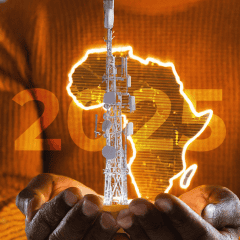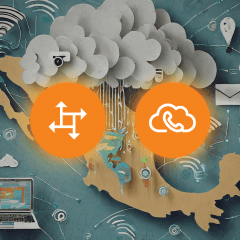Datora Group faced a critical challenge: scaling its infrastructure to handle a rapidly growing M2M and IoT business, all while managing over 4 million connected devices and billions of transactions annually. In this case study, we look at how a decade-long partnership between Datora and PortaOne enabled the company to migrate to the cloud, and achieve more than double the transaction capacity and a 30% increase in the customer base – all without sacrificing on the customer experience.
Size can be a significant competitive edge for a telecommunications business, but it can also make it challenging to innovate. Multi-channel, multi-sector, and multinational operations require complex infrastructure, making the integration of new technologies a resource-intensive process. Often, by the time a telecom operator adapts to new technology, it risks falling behind its competitors.
Brazil-based Datora Group has been navigating this dilemma since 1993, when it became the first provider of VoIP services in Latin America. Today, the company sells wholesale telephony services to 2,000 providers from offices in nine countries, while its mobile technology unit, Arqia, supports a wide range of M2M- and IoT-focused MVNOs (mobile virtual network operators). However, this growth was achieved over time, with a strong partnership along the way.
Here, we break down the history of the largest cloud migration and system optimization project PortaOne has undertaken, and explore how the collaboration between both companies delivered results that far exceeded initial expectations at every stage of this decade-long, multi-phased initiative.
Phase 1: Building the foundation for scalable VoIP capacity
Datora Group joined the PortaOne customer community in 2007, adding PortaSwitch to deliver its Vodafone-branded VoIP services. By 2016, the company’s on-site PortaSwitch installation, running maintenance release 50 (MR50), was processing about 450 calls per second. While this was significant for the era, it wasn’t robust enough to meet Datora’s goals for its growing long-distance operations, which required processing up to 1,000 calls per second. Expanding with additional hardware, however, proved too expensive and wouldn’t offer a sufficient return on investment.
In 2018, cloud technology for telecoms was still emerging. However, at the time, Datora’s system was mainly handling post- and pre-paid voice services, and moving it entirely to the cloud risked both a disruption of the company’s critical IP interconnections with its carrier partners, and coming in conflict with Brazilian regulatory requirements. PortaOne saw an opportunity and proposed a novel idea: move Datora’s billing operations to the cloud while keeping its critical SIP servers at the existing São Paulo datacenter.
The new PortaBilling cloud instance would run on Oracle Cloud Infrastructure (OCI), working in tandem with Datora’s existing hardware-based PortaSIP. This approach allowed Datora to add billing nodes as their customer base grew, without a proportional increase in budget, helping them meet their VoIP targets.
We choose to work with PortaOne because every time we bring them a challenge, they do what they can to meet it, and as a result, they develop new things. And that’s always good for us.
Daniel Fuchs, Head of Innovation, Datora Group

Phase 2: Enabling IoT growth with cloud-enhanced billing
Around the same time, Datora acquired a new mobile core to enter Brazil’s agricultural M2M and IoT market. This move was key to addressing the challenges faced by Brazil’s agricultural industry, including droughts and heatwaves, through smart watering, improved transport logistics, and biometric sensors for livestock welfare.
The company launched Arqia, an MVNO support network then targeting 1.5 million active IoT sensors to support the agriculture industry. Each IoT device, whether on a delivery truck or a pregnant cow, sends a small “ping” every 10–15 minutes. At 1.5 million connected devices, this generated transaction volumes that approached the limits of the VoIP-designed infrastructure.
PortaOne conducted in-depth testing, simulating different scenarios with enterprise clients, subscriber plans, tariffs, and other factors. Testing confirmed a system capacity of handling peaks of 1,270 transactions per second (TPS), exceeding Datora’s goal of 1,000 TPS.
Phase 3: Scalable infrastructure for continued cloud advancement
In May 2022, Oracle released DenseIO E4 virtual “flex shapes” – cloud infrastructure delivering high transaction volume at a low cost. The PortaOne project team leveraged this innovation to further increase Datora’s TPS capacity, allowing the company to scale even further without adding hardware.
By 2023, Arqia reached a major milestone: 3 million active SIM cards, processing 2,000 TPS with 2+ billion monthly transactions. These IoT devices played a vital role in improving efficiency in agriculture, reducing animal mortality, and boosting yields during Brazil’s uncertain climate.
PortaOne then updated Datora’s PortaSwitch cloud installation for its M2M and IoT traffic from an already outdated MR100 (released in June 2022) to a newer release (MR110, released in November 2023). Over the years, the PortaOne team had delivered several custom patches to improve performance for Datora, but now it was time to replace those patches with officially delivered code while allowing Datora to benefit from several performance optimizations in the newer release.
This required undertaking two consecutive Zero Downtime updates (first from MR100 to MR105, and then to MR110). PortaOne project manager Oleksandr Zaluhovskyi and the PortaOne support team worked with Datora to analyze and catalog all of the potential risks and create a detailed update plan to avoid or mitigate each one, resulting in a successful update.
PortaOne has a very reliable discovery process that, in most cases, allows us to uncover potential challenges and plan out a project from start to end before it ever begins. But sometimes our customer’s vision is so large and so long-term that we both know the technology is going to change along the way – and that the goalpost will too. When that happens, like it has with Datora Group, we rely on our close relationship and constant communication to get us all where we want to be.
Klaus Haertel, Director of Global Channel and Alliances, PortaOne

Phase 4: Optimizing cloud performance for cost-efficient added capacity
By 2024, Datora Group had become the largest OCI installation and MySQL database in the PortaOne customer community. At this scale, minor issues that might go unnoticed in a smaller system can become significant, putting both cost-efficiency and the company’s customer experience at risk.
To continue its success, PortaOne focused on optimizing Datora’s system to reduce the risk of future issues, and to ensure the company stayed competitive. Oleksandr led weekly optimization sessions throughout 2024, once again logging issues and prioritizing tasks. Like with the Zero Downtime Update project, Oleksandr then developed an optimization plan from those conversations, and the PortaOne team kicked off a series of refinements that each improved the efficiency and performance of the Datora system.
A central refinement in this stage was adding a new feature to PortaSwitch that further reduces the load on Datora’s database by “batching” balance updates for users that have particularly large TPS demands, such as call centers and IoT customers with tens of thousands of SIM cards. With this adjustment, PortaSwitch can now allow transactions to accumulate over a given interval, such as five seconds, and then process the transactions as a single batch. The improvement significantly reduces the risk of database locks and delays, and allows Datora to increase its capacity without needing to expand its system further.
Broad impact: Cloud-driven innovation for the entire telecom industry
The optimization work addressed multiple performance areas:
- It fine-tuned cloud resources to improve performance and allow PortaSwitch to handle higher TPS as Arqia continues its growth.
- The stand-by database was optimized for faster MySQL queries and handling the massive transaction volume in the case of a fail-over event.
- The system saw enhanced performance by preventing transaction concurrency in shared quota updates.
Plus, several features developed for Datora – including batch transaction processing, combined quotas for IoT/M2M SIM cards, and Brazilian Portuguese support for web interfaces – are now available to all PortaOne customers in current releases of PortaSwitch and PortaBilling.
Results: Achieving IoT scale through customized cloud migration
By the end of 2024, Datora had again reached record performance levels:
- 4 million active SIM cards (167% increase from 1.5M target)
- 1.14 billion monthly transaction records
- Peak capacity of 2,500 TPS (456% increase from original 450 TPS)
This project is the largest OCI installation PortaOne has ever taken on, with a huge number of complex issues to understand, communication channels to oversee, and stakeholders to cooperate with and report to on both sides. But for me, the more challenging a project is, the more exciting it is to work on. It is a real pleasure to work with the team at Datora, and to have a relationship with them that reaches back to when I first joined PortaOne in 2011.
Oleksandr Zaluhovskyi, PortaOne Project Manager

Takeaway: Partner with PortaOne for expert cloud migration
Datora’s transformation required multi-year experimentation to find the most effective balance of computing shapes, load, memory, speed, storage, and Oracle commercial agreements – all alongside rapid technological change. Thanks to their partnership with PortaOne, Datora is now equipped to meet the growing demands of the global M2M and IoT markets.
This success story is the result of constant, peer-to-peer collaboration and a shared drive to push beyond the conventional limits of telecom. PortaOne focuses on fostering close, individualized relationships with its customers to ensure that every project addresses the unique needs of each business.
If you’re looking for a tailored, long-term partnership to achieve scalable solutions and future-proof your telecom infrastructure, get in touch with PortaOne today.
The best solution to shrinking margins in the telecom industry is your own creativity. If you bring us your ideas, we can help you customize our platforms and create the integrations that help you bill and charge for those ideas.
Klaus Haertel, PortaOne
About Datora Group: Leaders in IoT and telecom innovation
Founded in 1993, Datora Group was the first company to provide VoIP services in Latin America. Today, with these business arms combined, Datora Group serves 2,000 enterprise customers and supports more than 4 million connected devices and 30 billion annual calls.
About PortaOne: Your partner for a successful cloud migration
PortaOne has been delivering flexible billing, business support, and cloud telephony software to forward-thinking telcos since 2001. Based in Vancouver, Canada, with technology offices in Ukraine and Spain, the company partners with more than 500 service providers to help them become market leaders while keeping their total cost of ownership under control.
Further reading
- Learn how Datora reached 3 million IoT devices
- Explore a case study in scalable IoT cloud billing
- Watch Datora CEO Daniel Fuchs speaks on his company’s growth at the 2024 PortaOne Barcelona Meetup
FAQ: Datora Group’s Cloud Migration with PortaOne
Datora Group faced the challenge of scaling its infrastructure to handle a rapidly growing M2M and IoT business, managing over 4 million connected devices and billions of transactions annually, while maintaining customer experience.
In 2010, Datora integrated PortaSwitch to deliver VoIP services. By 2016, their on-site PortaSwitch processed 450 calls per second. In 2018, PortaOne proposed moving Datora’s billing operations to Oracle Cloud Infrastructure (OCI) while keeping SIP servers on-site, enabling processing of up to 1,000 calls per second.
- VoIP (Voice over Internet Protocol): A technology that allows voice calls to be made over an internet connection instead of traditional phone lines.
- PortaSwitch: A software platform by PortaOne for managing VoIP, mobile, and other telecom services, including billing and routing.
- SIP (Session Initiation Protocol): A protocol used in VoIP to initiate, maintain, and terminate real-time communication sessions.
In 2018, Datora acquired a mobile core to support Brazil’s agricultural IoT market via Arqia, targeting 1.5 million IoT sensors. PortaOne moved Datora’s billing to OCI, allowing scalable billing nodes. Testing confirmed a system capacity of 1,270 transactions per second (TPS), exceeding the 1,000 TPS goal.
- IoT (Internet of Things): A network of interconnected devices that communicate data over the internet, often used in M2M applications.
- M2M (Machine-to-Machine): Direct communication between devices using wired or wireless networks, often for IoT applications.
In May 2022, Oracle’s DenseIO E4 virtual “flex shapes” enabled PortaOne to increase Datora’s TPS capacity, allowing Arqia to reach 3 million active SIM cards and process 2,000 TPS with over 2 billion monthly transactions by 2023.
- Cloud Infrastructure: A virtualized environment providing computing, storage, and networking resources, like OCI, to support scalable telecom operations.
In 2024, PortaOne optimized Datora’s system by adding batch processing to PortaSwitch, reducing database load for high-TPS users like IoT customers. Weekly optimization sessions addressed minor issues, improving efficiency and ensuring competitiveness.
- Batch Processing: A method of processing multiple transactions in a single operation to optimize system performance and reduce resource usage.
By 2024, Datora achieved 4 million active SIM cards (a 167% increase from the 1.5M target), 1.14 billion monthly transaction records, and a peak capacity of 2,500 TPS (a 456% increase from a starting point of 450 TPS).
PortaOne performed two consecutive Zero Downtime updates (from MR100 to MR105, then to MR110) in 2023. Project manager Oleksandr Zaluhovskyi analyzed risks and created a detailed update plan, replacing custom patches with optimized code from newer releases. Using Dual Version PortaSwitch, PortaOne enabled gradual migration, ensuring no service interruptions. For more on how Dual Version supports Zero Downtime updates, explore PortaOne’s YouTube playlist with FAQs, walk-throughs, and benefits of gradual software updates, or visit the Dual Version White Paper.
- Zero Downtime: A process ensuring system updates or migrations occur without interrupting service availability.
- Dual Version: A PortaOne feature allowing gradual migration between software versions or from on-premise to cloud, minimizing downtime risks by migrating customers in batches.
PortaOne’s decade-long partnership with Datora delivered a tailored cloud migration, scaling from 450 TPS to 2,500 TPS and supporting 4 million IoT devices. Their reliable discovery process, close collaboration, and custom solutions ensure scalable, future-proof telecom infrastructure.







